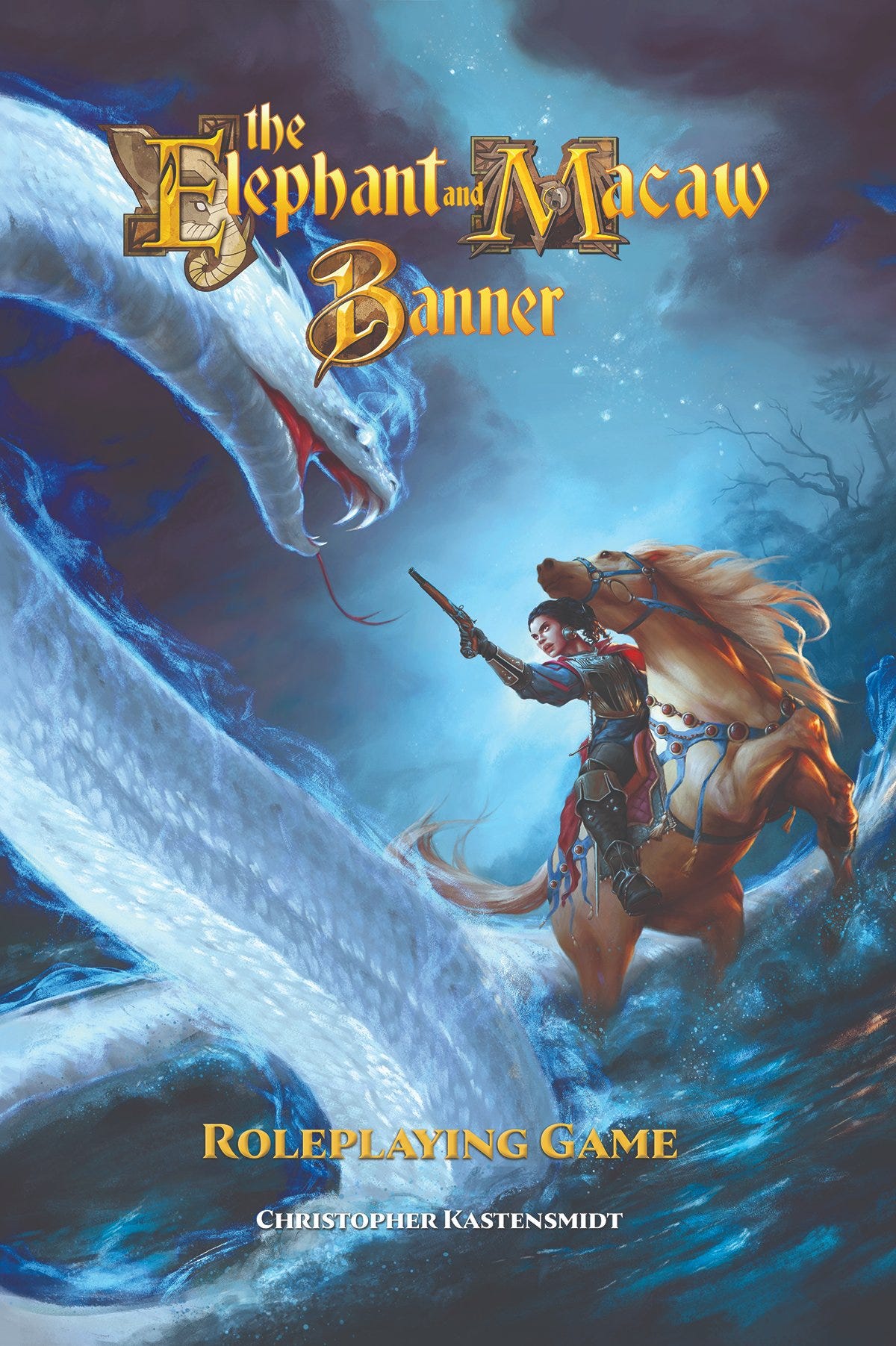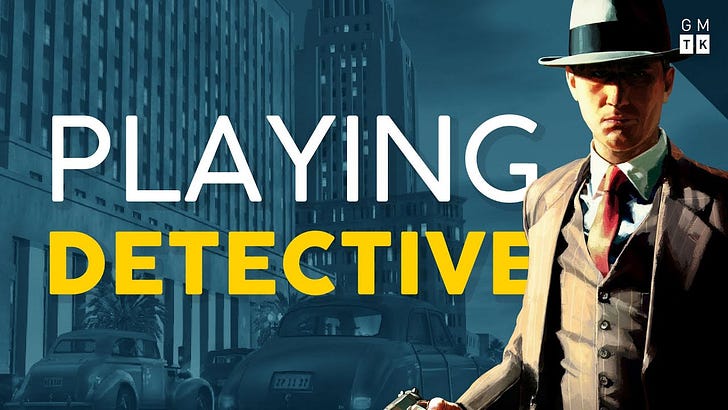#3: Playing Detective, Going Solo, South America and More!
the best issue of the Indie RPG Newsletter yet!
Dear reader, it was a humid summer day when out of nowhere, the 3rd issue of the Indie RPG Newsletter came hurtling into my inbox. It was Saturday and I knew I was in trouble…
Let’s dive in!
I. Being a Detective in a TTRPG!
I’ve been thinking about mysteries, investigations, clues, crimes and detectives this week. Why, you ask? Well, I reply in a voice so gravelly that it sounds like I eat rocks for breakfast, that’s a damn good question. Making a good detective game is really hard. I think of detective games as a slightly cursed problem in game design because when you hear “detective game” as a player, you feel like two promises are being made to you. First, the promise that you’ll get to use your wits and crack tricky problems. And second, the promise that you’ll get an exciting and satisfying mystery story. But these two promises conflict with each other to some extent. Being faced with a tricky problem means that you might not be able to solve it. But if can’t solve it, its very frustrating and not at all a good story!
Here’s a full breakdown of this problem using video games as examples:
It’s a great video, you should watch it.
Among indie RPGS, I believe (insert usual disclaimers about personal opinions, etc) that most of them look at those two conflicting promises (telling a good story and challenging the player’s detective skills) and then decide to focus on the good story part of it.
Take GUMSHOE. It’s the classic recommendation for those who want a mystery game and it does an excellent job of emulating the genre. It’s big innovation is that you always find the clue. Because you’re a detective and in detective stories, the detective finds the clue. (Imagine you had to roll to find a clue. Now imagine you failed the roll. What happens now?) But the problem with GUMSHOE is that I feel like it imagines a good campaign as one where the clues act like breadcrumbs that lead the players from the start to the end. Your job as GM is to lay the breadcrumbs well. To me, this isn’t very interesting.
But I wasn’t sure about this so I asked on reddit and the resulting discussion was really interesting! One person said this:
I played in a Fear Itself ghost story game and it was great. The clues did point in the direction of the next step, but at any given time we were juggling a couple different, semi-independent clues and what exactly they meant required player guesswork and following up on hunches. One of my favorite examples was the phrase "green fear", which was picked up by our medium from some unidentified ghost. I OOC googled it and found it was a phrase used by Homer to describe fear of the supernatural, which lead me, the player, to infer that the character/ghost who used it must have been classically educated in order to be familiar with the phrase, which lead me down a targeted path of questioning/investigation to try to determine the identity of the ghost.
None of that was mechanical, it was all me the player latching onto a strange clue and deducing something else sort of tangential to it and following up on that in-character.
How cool is that? I want to feel like this! I want to do this! I want clues to not to be breadcrumbs. I want clues to be puzzles! I want clues to be meaningful decisions! And I think right now, there isn’t a TTRPG system that does that. This person was playing a GUMSHOE game but damn, that isn’t how the system is supposed to work. According to the rules, the GM was supposed to be like “Tea, you’ve got Classics, right? So you recognize that ‘green fear’ means this and that ….”
I guess for now Sherlock Homes: Consulting Detective, the boardgame, is the closest way to experience the thrill of actually solving crimes. But it’s not an RPG. So maybe I should design something that combines both…?
II. Why Do People Design Games?
“When someone asks, why do people design games, roll 2d6.
On a 10+, choose 1.
On a 7-9, choose 2.
On 6-, choose 3.
Because:
They played D&D and hated it.
They used their imagination to create a setting or adventure and welp that’s game design, friendo.
Tinkering with rules is a natural extension of having rules.
It is a job like any other.
They have the hubris of the gods!
They don’t have a steady gaming group and designing a game feels a lot like like playing.
Making a game is an art and like all art is form of play that satisfies a vital part of ourselves.
Making a game is an act of self-expression like writing a poem and this is the same as point 5 isn’t it. Yes.”
III. Have you ever walked the path of the solo RPG?
Because there’s an entire subreddit dedicated to it. It’s much more popular than you’d imagine. At least, more popular than I imagined. Clearly, my imagination could be working harder! *cracks whip*
If you’re new to the concept, people play regular RPGs solo using GM emulators or other tools. On the most basic level, players use dice to answer yes-or-no questions as they play. “Is this highway bandit in a good mood? Let’s ask the dice!” Here’s a great small system for doing that called Recluse. There’s much more elaborate ones - like the Mythic GM Emulator which has some nifty tricks to introduce twists and so on.
There’s a pretty popular solo roleplaying show by a professional voice actor called Me Myself and Die! He uses Mythic GME during the show and in one of his videos, he talks about the emulator and how he uses it to tell an interesting story. It’s quite cool.
Honestly, I’m not sure if I’ll love or hate solo roleplaying. But hey, I am a writer and this is like writing but with dice, right? Right?
IV. RPGs from South America!
Ramanan Sivaranjan recently wrote about the Brazilian OSR on his blog recently. The article makes for a great list of really interesting creators. If you like OSR games, you probably already know Diogo Nogueira who has made a huge number of really cool games like Solar Blades and Cosmic Spells and Lost in the Fantasy World. But Ramanan mentions lots of other designers too so check out that article.
Staying on Brazil for a moment, I’m a huge fan of Tom of Porcupine Games who translated The Elephant and the Macaw Banner into English. It’s an RPG based on a series of novels set in a magical 16th century Brazil and while I haven’t played it yet, it looks awesome! If you like The Witcher, this might be something you might like.

Another South American game I want to talk about is The Labyrinth of Verra by Joaquín Ollo, an Argentinian designer. While I’m not a huge fan of the retro aesthetic of the game’s layout, I absolutely love this game. It’s Very Weird. I mean, you play ever-mutating fragments of an ancient god that have become sentient. Cool, right? In some sense, it’s an old school dungeon crawl. But at the same time, it’s completely unique. The magic system is chaotic and wild and fun. You eat other monsters and gain their memories. So many reasons to check it out.
I’m sure there are lots more out there and I’m definitely going to keep talking about other games and designers from South America in future editions.
V. Miscellaneous
A huge list of resources about accessibility in tabletop RPGs put together by Jennifer Kretchmer, a disability consultant.
Battling Inner and Outer Demons: an interview I did with the founders of Witch & Craft Games for Cannibal Halfling Gaming.
The Gauntlet Community is proud to present a free weekend of open online gaming, taking place Thursday, October 15 through Sunday, October 18.
VI. Small Ads
This section contains sponsored links and advertisements.
Suzerain: where supernaturally powerful heroes fight evil across many realms. Our Kickstarter begins soon and you can find out more at playsuzerain.com, scoring free loot along the way!
These ads help keep this newsletter going. If you’d like to advertise with the newsletter, the submission form with all the guidelines can be found here.
This has been the most jam-packed edition of the newsletter yet. I’ve really enjoyed writing it. Please consider sharing the newsletter with friends - on your discords or social media. When I hit 500 subscribers, I’ve promised to start facilitating game reviews by connecting designers together - full story in last week’s newsletter. We’re at about 270 subscribers right now!
Also, this newsletter contains images. If you’re not seeing them, you’re not getting the full experience!
As always, thank you for reading! Have a good day! And if you’d like to discuss this week’s newsletter, you can comment here or message on twitter @chaibypost.


